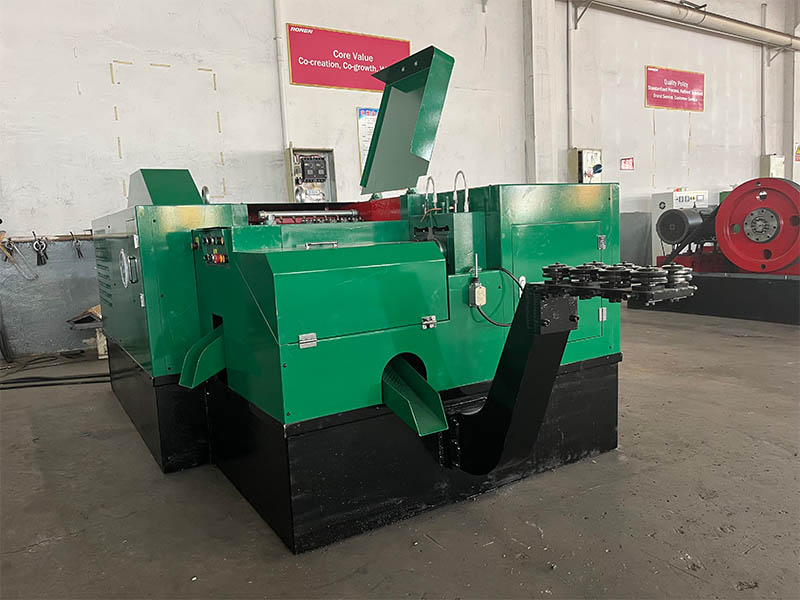
The Ronen®6 Station Nut Former Making Machine shapes blanks in six steps: wire cutting, upsetting, initial forming, hexagonal forming, trimming, final polishing. No need to move blanks between molds; operators don’t monitor continuously—ideal for the supplier.
6 Station Nut Former Making Machine uses six consecutive cold extrusion stations to gradually transform the metal wire into a nut blank. The molds at each workstation are independent. If one mold gets damaged, just replace that one instead of the entire set. This can save a lot of money on molds.
The Nut Former Making Machine produces nuts in six steps. First, a steel wire is cut, and then it is sent to each workstation. Different tools shape the blank, form it into a hexagon, punch holes and thread, and finally transform a simple block-like part into a finished nut. No manual intervention is required.
The 6 Station Nut Former Making Machine uses the cold forging process, which enables the metal to be shaped without the need for heating. This process makes the nuts more sturdy and reduces energy consumption. Because it forms the nuts by replacing the metal rather than cutting it, the amount of waste generated is also very small.
The maintenance of the Nut Former Making Machine usually involves the punch and the mold. These components will wear out due to the high pressure during metal forming and need to be replaced regularly. To produce stable and high-quality nuts, it is necessary to keep the mold in good condition.
| Specification | Unit | 11B | 14B | 17B | 19B | 24B | 27B | 30B | 33B | 36B | 41B |
| Forging Station | No. | 6S/7S |
6S/7S |
6S/7S |
6S/7S |
6S/7S |
6S/7S |
6S/7S |
6S/7S |
6S/7S |
6S/7S |
| Max Cut-Off Dia | mm | 11 | 15 | 17 | 19 | 24 | 27 | 30 | 33 | 36 | 41 |
| Kick-out Length | mm | 20/30/40 | 20/30/40 | 25/40/60 | 25/30/40/60/80 | 30/60/80 | 30/40/60/80 | 30/40/60/80 | 40/60/80/100 | 50/60/80/100 | 50/60/80/100 |
| Dies Pitch | mm | 50 | 60 | 70 | 80 | 100 | 110 | 120 | 140 | 150 | 160 |
| Forging Power | Ton | 60 | 90 | 110 | 135 | 230 | 260 | 300 | 360 | 420 | 650 |
| Production Size |
|
M3-M6 | M6-M10 | M8-M12 | M8-M14 | M10-M18 | M12-M18 | M14-M20 | M16-M22 | M18-M24 | M20-M27 |
| Output | min/pcs | 250 | 180 | 150 | 140 | 70 | 60 | 60 | 90 | 80 | 70 |
| Main Motor | Hp | 15 | 20 | 30 | 50 | 75 | 100 | 125 | 150 | 250 | 350 |
| Lubrication Motor | Hp | 1.5 | 1.5 | 1.5 | 1.5+3 |
1.5+3 |
1.5+3 |
1.5+3 |
1.5+3 |
1.5+3 |
1.5+3 |
| Lubricant | L | 700 | 1000 | 1100 | 1200 | 1700 | 2300 | 2000 | 2400 | 2400 | 2400 |
| Approx Weight | Ton | 4.5 | 8 | 11 | 14 | 25 | 38 | 42 | 45 | 70 | 73 |
The selling point of the 6 Station Nut Former Making Machine is "multi-station finishing", which enables it to produce slightly more complex nuts without the need for additional processes. For example, nuts with small steps, and nuts with anti-slip patterns on the edges. The length of the opposite sides of the hexagonal nut can be controlled within an error of 0.06 millimeters, and it won't get stuck when tightening the bolt.
